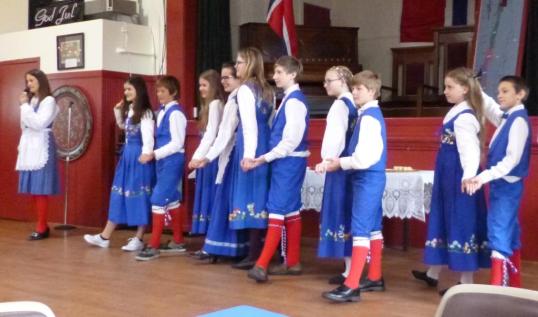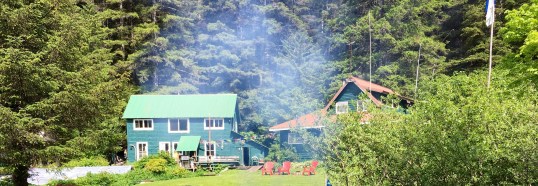Freeway Free in Alaska: Up the Inland Passage into the Wild
 I confess: I did not come to Alaska to learn more about Tlingit culture or early Norwegian settlesments. I wanted to experience wilderness and wildness, before they disappear from the earth. When we sail up into Tracy Arm north of Hobart Bay, I feel like we were really there.
I confess: I did not come to Alaska to learn more about Tlingit culture or early Norwegian settlesments. I wanted to experience wilderness and wildness, before they disappear from the earth. When we sail up into Tracy Arm north of Hobart Bay, I feel like we were really there.
I wake up and open the curtain to see a big blue berg floating by – we are approaching Sawyer Glacier, shining in every tone of teal between near- navy and shadowy ice blue. As we watch, a large section of the glacier calves off, with a huge splash followed seconds later by the deep roar. 
Later we make our way up toward Glacier Bay. One of our group sights a group of orca between our boat and a smaller tour boat a bit further into the Bay. Suddenly an orca breaches, throwing itself clear out of the water. It is half the size of the small tour boat, and no more than 20 feet away from it. Shamu at SeaWorld could not have shown off to better effect.
We sail into Glacier Bay, feeling smug because our smallish boat can go much further in that the multi-thousand passenger cruise ships we pass. The first peninsula jutting into the bay is Gloomy Gloomy Knob, the home of mountain goats. We saw several Rams and one foursome of ewes and kids – then the foursome began running – they had been spooked by a drone zooming by for a close-up. Flying drones close enough to disturb wildlife is illegal in National parks. Our on-board Park Ranger Nicole bolts for the captain’s bridge and its radio, gets the offending boat on the wire.. The droners deny the drone was anywhere other than near the beach! But we have photos! Geez Louise!
Further in we spot a moose mama with twin calves (she looking quite skinny – the effect of nursing two?) As we circle around the bay we see three bears on the rocky moraine which constitutes a beach. The mother bear is badly scarred either from skin disease or perhaps a burn and sparks from a fire, but not crippled. The two cubs are happily turning over rocks looking for shrimp or small fish sheltering underneath. 
We get off the boat at Lumpaugh Glacier and walk on a glacial moraine- lumpy, shifting, insecure footing. The bears looked more comfortable and secure – perhaps claws and flexible pads give them better traction? It’s odd to imagine these rocks ranging from tiny pebbles to boulders being carried and then dropped by the slow river of ice moving back and forth across this empty land. Maybe it wasn’t so empty then. Maybe the Tlingit shamans tried to find some explanation for climate change. Did they blame the actions of Man for having angered the Gods? Does nothing change?



 Our next stop up the Inland Passage was at the town of Petersburg, settled originally by a group of Norwegians over 100 years ago. We were entertained by a group of students dressed in traditional
Our next stop up the Inland Passage was at the town of Petersburg, settled originally by a group of Norwegians over 100 years ago. We were entertained by a group of students dressed in traditional  David’s travel notes: W
David’s travel notes: W

 Cruising along the Inland Passage of Alaska reveals few “tourist traps.” The landscape is simply too big to allow any encroachment by man to seem significant against the surrounding mountains, glaciers, and ocean. Just standing on the upper deck of our small cruise boat allows us to take in vistas of ice, snow, forest, and water which make the occasional human settlement seem irrelevant. Still, we need to stretch our legs daily, and there are stops which allow us to focus our eyes on things less than 100 yards away.
Cruising along the Inland Passage of Alaska reveals few “tourist traps.” The landscape is simply too big to allow any encroachment by man to seem significant against the surrounding mountains, glaciers, and ocean. Just standing on the upper deck of our small cruise boat allows us to take in vistas of ice, snow, forest, and water which make the occasional human settlement seem irrelevant. Still, we need to stretch our legs daily, and there are stops which allow us to focus our eyes on things less than 100 yards away. For Alaska’s centennial the wood carvers of Kare created the worlds largest totem pole, originally 168 feet high. Totem poles, however, are not designed as long-lived memorials; the top twelve feet with its watchward Raven fell victim to weather and wind and now lie in the grass next to the splintered and faded pole.
For Alaska’s centennial the wood carvers of Kare created the worlds largest totem pole, originally 168 feet high. Totem poles, however, are not designed as long-lived memorials; the top twelve feet with its watchward Raven fell victim to weather and wind and now lie in the grass next to the splintered and faded pole.  The lead dancer is a black man adopted into the tribe on marriage with a Tlingit woman. He dances in a finely embroidered cape made for him by his mother-in-law as a memorial to his daughter, who was murdered while walking home from a dance the previous year by a boy from a rival clan. At the end of the dance the family of the murdered girl is presented with a ceremonial paddle marking her passage to the afterworld now that a year of mourning has passed.
The lead dancer is a black man adopted into the tribe on marriage with a Tlingit woman. He dances in a finely embroidered cape made for him by his mother-in-law as a memorial to his daughter, who was murdered while walking home from a dance the previous year by a boy from a rival clan. At the end of the dance the family of the murdered girl is presented with a ceremonial paddle marking her passage to the afterworld now that a year of mourning has passed. Sitka is the launch point for many voyages up the inland passage. But don’t be in a hurry to leave. In addition to the
Sitka is the launch point for many voyages up the inland passage. But don’t be in a hurry to leave. In addition to the 












 On my travels in June I met a modern-day visionary. His name is Zachary Brown, he wears rumpled plaid shirts and jeans and hiking boots, and he is the co-founder, executive director, and so far the sole employee of the
On my travels in June I met a modern-day visionary. His name is Zachary Brown, he wears rumpled plaid shirts and jeans and hiking boots, and he is the co-founder, executive director, and so far the sole employee of the 
